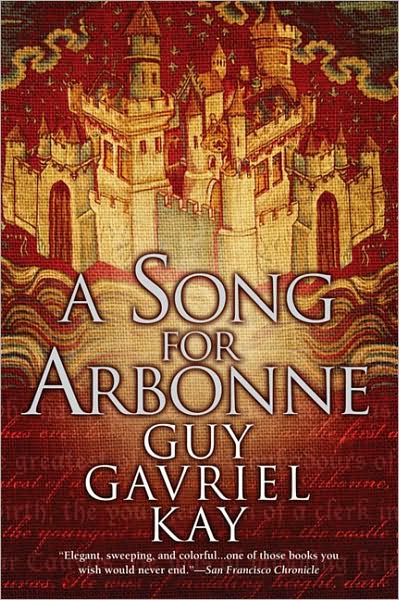I hadn’t read A Song For Arbonne for so long that I’d almost forgotten the story, and that’s why I took it with me to re-read this summer. I remembered the setting perfectly well—this is a fantasy version of medieval Provence, with fields of lavender and the Court of Love and troubadours. The characters, however, and the plot, had vanished from my mind in the ten years or so since I last read it, except for a few set-piece moments, of the kind Kay does so well.
Kay’s career as a fantasy writer has gone on an odd trajectory, beginning with Tolkien-style secondary world fantasy (The Fionavar Tapestry) and then swinging away deeper and deeper into history. Tigana and A Song for Arbonne are set in secondary worlds that resemble their historical counterparts, from The Lions of Al-Rassan onwards his books are telling the stories of the actual historical people and places he is abstracting. So what we have here is a world closely based on the real Provence, and original characters and plot. This is also a trajectory away from magic—Fionavar is full of magic, Tigana has somewhat less, Arbonne has less again, and The Lions of Al-Rassan has nothing but an accurate prophecy.
The world is portrayed beautifully, in effective, evocative and memorable detail. I think this is the problem with the book—the world is more memorable and somehow denser than the characters, who are in comparison gossamer. As for the plot, it’s fairly standard for fantasy—there’s a mercenary who happens to be a potential heir to the threatening neighbour kingdom, there’s a scheming father, there are two lords at odds over a long-ago love affair but who need to work together to save the kingdom. There’s a missing heir, there are islands full of prophetic priestesses, there are too many people who have secrets—and it’s all mannered and distanced and held at arm’s length. It’s not that it’s a bad book. It’s a very good book, it’s just that it can’t hold its own weight—the world and the writing and the beautiful set-pieces are enough to carry me along, but there rest of it is too slight, too conventional, and too distanced to keep its end up. It’s like a tapestry containing jewels heavy enough to tear through the fabric.
Maybe I was just in the wrong mood for it. I know I’ve enjoyed reading it before. But I kept wanting to enjoy it and finding myself being distracted by thinking about it. I’m actually a very bad reviewer, which is another reason I don’t review much. I have no detachment. I get sucked into a book and seduced by it while I’m reading it. Any analysis happens after the fact. These posts (which are not really reviews, just burbling about books) get written after I’ve finished the book and had time to think about what I think about it. While I’m reading, usually, I am the book, there’s no line between the book and me. With A Song For Arbonne, this time, that trance state never happened—I was always enjoying it well enough, skimming along the surface, but it never grabbed hold of me and sucked me under. I kept thinking this was because I wasn’t giving it enough time—I started it when I was in Britain, and busy, and without long chunks of time to read. But I read the second half of it on the plane home, without any interruption and it still didn’t happen.
After this book, Kay moved more towards writing characters and plots that were also historical. After this reading I wonder if he might have done that because he wanted them to have the same weight as the backgrounds? Also after this he tended to write about people doing things for human reasons, some of them petty, but none of them evil in the fantasy sense of the word. I wonder if these kinds of stories and characters had come to feel as if they weren’t enough?
Jo Walton is a science fiction and fantasy writer. She’s published eight novels, most recently Half a Crown and Lifelode, and two poetry collections. She reads a lot, and blogs about it here regularly. She comes from Wales but lives in Montreal where the food and books are more varied.










